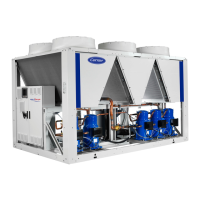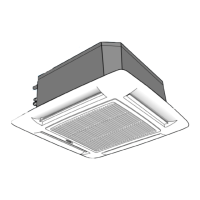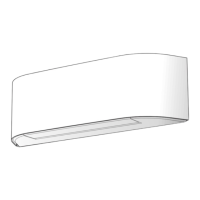6
All factory-installed safety valves are lead-sealed to prevent
any calibration change. If the safety valves are installed on
a reversing valve (change-over), this is equipped with a
safety valve on each of the two outlets. Only one of the two
safety valves is in operation, the other one is isolated. Never
leave the reversing valve in the intermediate position, i.e.
with both ways open (locate the control element in the stop
position).
If a safety stop is removed for checking or replacement
please ensure that there is always an active safety stop on each
of the reversing valves installed in the unit.
The external safety valves must always be connected to drain
pipes for units installed in a closed room. Refer to the
installation regulations, for example those of European
standard EN 378 and EN 13136.
These pipes must be installed in a way that ensures that
people and property are not exposed to refrigerant leaks.
As the uids can be diffused in the air, ensure that the outlet
is far away from any building air intake, or that they are
discharged in a quantity that is appropriate for a suitably
absorbing environment.
Periodic check of the safety valves: See paragraph 1.3 -
“Maintenance safety considerations”.
Provide a drain in the drain pipe, close to each safety valve,
to avoid an accumulation of condensate or rain water.
All precautions concerning handling of refrigerant must be
observed in accordance with local regulations.
Ensure good ventilation, as accumulation of refrigerant in
an enclosed space can displace oxygen and cause asphyxiation
or explosions.
Inhalation of high concentrations of vapour is harmful and
may cause heart irregularities, unconsciousness, or death.
Vapour is heavier than air and reduces the amount of oxygen
available for breathing. These products cause eye and skin
irritation. Decomposition products are hazardous.
1.2 - Equipment and components under pressure
These products incorporate equipment or components under
pressure, manufactured by Carrier or other manufacturers.
We recommend that you consult your appropriate national
trade association or the owner of the equipment or
components under pressure (declaration, re-qualication,
retesting, etc.). The characteristics of this equipment/these
components are given on the nameplate or in the required
documenta-tion, supplied with the products.
These units are intended to be stored and operated in an
environment where the ambient temperature must be not
less than the lowest allowable temperature indicated on the
nameplate.
Do not introduce signicant static or dynamic pressure with
regard to the operating pressures used during operation or
for tests in the refrigerant circuit or in the heat exchange
circuits.
1.3 - Maintenance safety considerations
Carrier recommends the following drafting for a logbook
(the table below should not be considered as reference and
does not involve Carrier responsibility):
Intervention Name of the
commissioning
engineer
Applicable
national
regulations
Verication
Organism
Date Nature
(1)
(1) Maintenance,repairs,regularverications(EN378),leakage,etc.
Engineers working on the electric or refrigeration components
must be authorised, trained and fully qualied to do so (e.g.
electricians trained and qualied in accordance with IEC 60364
classication BA4).
All refrigerant circuit repairs must be carried out by a trained
person, fully qualied to work on these units. He must have
been trained and be familiar with the equipment and the
installation. All welding operations must be carried out by
qualied specialists.
Any manipulation (opening or closing) of a shut-off valve
must be carried out by a qualied and authorised engineer.
These procedures must be carried out with the unit shut
down.
Any intervention on the refrigerant circuit, including
changing of drier blocks, is only permitted after the complete
removal of the refrigerant charge. For these units transfer
of the refrigerant charge from the high or low-pressure side
is not possible, nor permitted.
Never use the compressor as a vaccum pump.
During any handling, maintenance and service operations
the engineers working on the unit must be equipped with
safety gloves, glasses, shoes and protective clothing.
Never work on a unit that is still energised.
Never work on any of the electrical components, until the
general power supply to the unit has been cut using the
disconnect switch in the control box.
If any maintenance operations are carried out on the unit,
lock the power supply circuit in the open position ahead of
the machine.
If the work is interrupted, always ensure that all circuits
are still deenergized before resuming the work.
ATTENTION: Even if the compressor motors have been
switched off, the power circuit remains energized, unless the
unit or circuit disconnect switch is open. Refer to the wiring
diagram for further details.
Attach appropriate safety labels.

